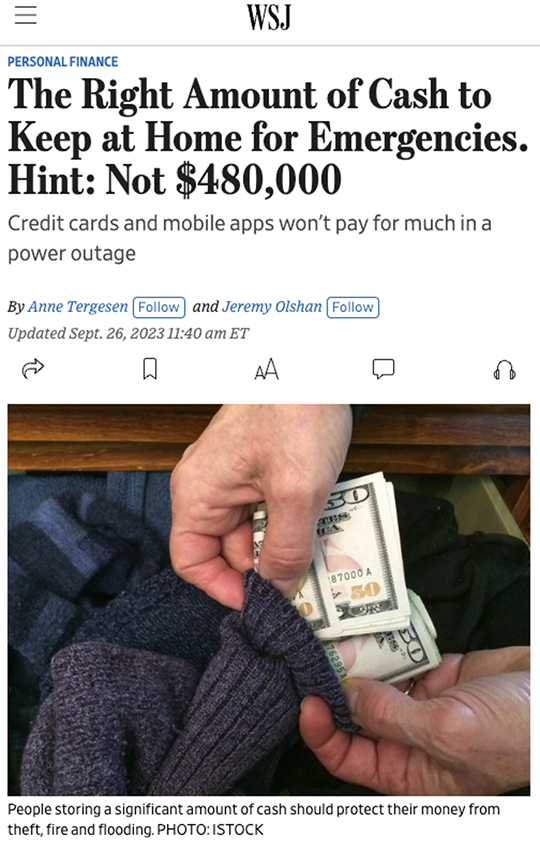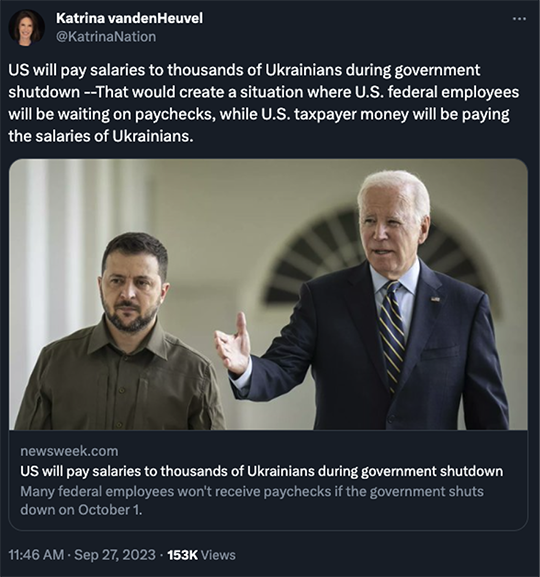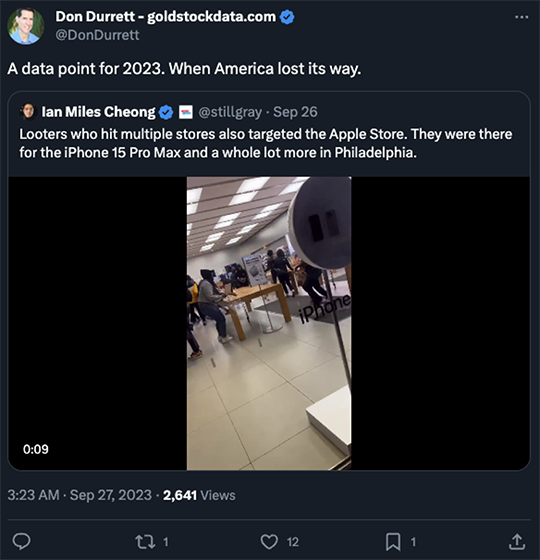Costco Gold and Biden Bucks
- The Wall Street Journal’s highly subversive article
- Costco gold: Even more innovative than the mainstream thinks
- The market’s no-good, mostly bad September
- Oh no, not again
- The mailbag: Civil unrest
![]() The Wall Street Journal’s Highly Subversive Article
The Wall Street Journal’s Highly Subversive Article
 Our first two bullets today have to do with the long-term core holdings that belong in everyone’s portfolio, according to Paradigm’s Jim Rickards.
Our first two bullets today have to do with the long-term core holdings that belong in everyone’s portfolio, according to Paradigm’s Jim Rickards.
For more than a decade Jim has extolled the virtues of cash, gold, land, fine art and private equity.
Some of those are more readily accessible to retail investors than others. The two that are on our mind today are the easiest to obtain — cash and gold.
 Not that its editors realized it, but The Wall Street Journal published a truly subversive article two days ago.
Not that its editors realized it, but The Wall Street Journal published a truly subversive article two days ago.

Prompted by the bribery indictment of Sen. Robert Menendez (D-New Jersey), the Journal took on the question of how much physical cash should you keep around the house in case of emergencies?
In case you hadn’t heard, investigators say they found more than $480,000 “stuffed into envelopes and hidden in clothing, closets and a safe” at Menendez’s home.

That’s a lot of Benjamins [U.S. Attorney photo]
In his defense, Menendez said, “For 30 years, I have withdrawn thousands of dollars in cash from my personal savings account, which I have kept for emergencies, and because of the history of my family facing confiscation in Cuba.”
The Cuba claim is risible: Menendez’s family left Cuba for the United States in 1953 — six years before Castro and his commie henchmen seized control of the country.
 But cash around the house for an emergency? Of course that makes sense.
But cash around the house for an emergency? Of course that makes sense.
The Journal article consulted a number of experts about the appropriate amount to keep on hand. Answers ranged anywhere between $200 and two weeks’ worth of expenses. It’s especially wise if you’re vulnerable to hurricanes, wildfires and such.
“Here in Florida,” said financial adviser Paul Auslander, “you tend to keep enough cash on hand to get through two–four weeks of no ATMs and electrical power failure sufficient to keep your credit card from working at a grocery store.”
 Meanwhile, the Department of Homeland Security labels cash as something you should only “consider” — and not part of a “basic disaster supplies kit.”
Meanwhile, the Department of Homeland Security labels cash as something you should only “consider” — and not part of a “basic disaster supplies kit.”
Well, of course they wouldn’t. They’re the government, after all. And the government is keen to implement a CBDC — a central bank digital currency, or in Jim Rickards’ parlance, “Biden Bucks.”
The whole idea is to eliminate physical cash — the better to track your every transaction.
With a CBDC, “they see everything you buy, your charitable contributions, your political donations, your entertainment choices, your travel and more,” Jim reminds us.
“When that information is combined with geospatial location (from the GPS data on your iPhone, E-ZPass toll transmitters and license plate scanners) and analyzed by artificial intelligence applications, it’s easy to develop a political profile of you.”
Should you end up on a government enemies list, “CBDCs can be used to freeze your bank accounts. This happened to the Freedom Convoy drivers in Canada in January 2022. It can easily happen here.”
 Thus, the Journal is undermining the Biden Bucks agenda by even broaching the subject of cash for emergencies. Good on them.
Thus, the Journal is undermining the Biden Bucks agenda by even broaching the subject of cash for emergencies. Good on them.
The advocates of CBDCs and other cashless-society schemes never address how everyday folks are supposed to conduct transactions during a power outage.
Power outages happen even in the best of times — again, wildfires, hurricanes, etc. And as we’ve chronicled regularly in recent years, the power grid is under increasing stress: Coal and nuclear plants are being mothballed, and there’s nowhere near enough wind and solar capacity coming online to replace it. Oh, and all this is happening at the very time more people are demanding more juice as they adopt electric vehicles.
How are you supposed to cope with no cash and no power? Well, that’s why Jim recommends a worst-case-scenario stash of physical gold and silver on hand (and not in a bank).
You hope it never comes to that… but as the saying goes, hope is not a plan.
![]() Costco Gold: Even More Innovative Than the Mainstream Thinks
Costco Gold: Even More Innovative Than the Mainstream Thinks
 Which brings us to gold — the other long-term core holding on our mind today.
Which brings us to gold — the other long-term core holding on our mind today.
Costco issued its quarterly numbers on Tuesday — and within the last 36 hours, a casual remark during the follow-up conference call has gone viral. The top “trending” story on CNBC, for instance, is…

“I’ve gotten a couple of calls that people have seen online that we’ve been selling 1-ounce gold bars,” said CFO Richard Galanti. “Yes, but when we load them on the site, they’re typically gone within a few hours, and we limit two per member.”
It’s true. Online only, not in-store…

According to chatter on Reddit, the bars sell for a crazy-low premium over the spot gold price — less than $25 an ounce. And “executive”-level Costco members get 2% cash back. Hard to beat.
“They’ve done their market research,” says Jonathan Rose of Genesis Gold Group — pointing out how Costco has also upped its offerings of prepper-type items like freeze-dried foods.
“There is definitely a crossover of people living off the land, being self-sufficient, believing in your own currency,” Rose tells CNBC. “That’s the appeal to gold as a safe haven as people lose faith in the U.S. dollar.”
Colleague Greg Guenthner quips: “Pretty insane that gasoline and gold are both loss leaders at COST in 2023.” (Imagine if they start selling ammo…)
 Here’s the most intriguing aspect of Costco’s gold gambit — one that’s too nuanced for the mainstream to take on.
Here’s the most intriguing aspect of Costco’s gold gambit — one that’s too nuanced for the mainstream to take on.
See, for many gold bugs, the only type of product they’re willing to buy is a coin issued by a government mint — a U.S. Eagle, a Canadian Maple Leaf, a South African Krugerrand, an Austrian Philharmonic.
Right or wrong, the perception is that a government’s imprimatur on a 1-ounce hunk of gold amounts to a guarantee of weight, purity, etc. that you don’t get with a generic 1-ounce gold bar. If God forbid you have to part with your gold to conduct a transaction, the other party is more likely to trust your government-issued coin.
For that reason, the premium you pay for a government-issued gold coin is almost always higher than that for a generic gold bar. At our affiliated firm Hard Assets Alliance this morning, for instance, there’s a $60 “spread” between the price of a 1-ounce bar and a 1-ounce Gold Eagle.
So Costco’s gold bars could be a game-changer. A reputable retailer is giving its backing to gold bars from two different refiners — PAMP Suisse and Rand Refinery.
Those bars are acquiring a cachet, a legitimacy, nearly as good as a government mint mark. All hail private-sector innovation!
![]() The Market’s No-Good, Mostly Bad September
The Market’s No-Good, Mostly Bad September
 The month of September is shaping up to be like the entire year of 2022 — with both stocks and bonds sucking eggs.
The month of September is shaping up to be like the entire year of 2022 — with both stocks and bonds sucking eggs.
The S&P 500 has slipped 5% this month… while the yield on a 10-year U.S. Treasury note has sailed up to its highest level since 2007.
The mainstream is trying to chalk it up to the Federal Reserve’s intentions to keep short-term interest rates “higher for longer.” But the Fed telegraphed that intention only eight days ago, while stocks and bonds have been struggling all month.
One difference from 2022: Gold cushioned the blow from stock and bond losses in a well-balanced portfolio last year; the gold price ended the year more or less where it began.
Not now: Spot gold began September at $1,940 and after yesterday’s whacking ended up at $1,875. (We’ll leave it to others to draw any connections between the Costco news and yesterday’s sell-off — heh.)
And the selling continues today, with gold down another $5 to $1,870. Chart hounds say there’s support at $1,800 — but if that breaks, the next downside target is $1,615. Fortunately they say that level would be almost impossible to take out.
 At least energy has been a bright spot in an otherwise dismal September — as it was during a dismal 2022.
At least energy has been a bright spot in an otherwise dismal September — as it was during a dismal 2022.
Crude spiked over $3 to $93.68 yesterday — a level last seen in August 2022. It’s backed off about a buck today.
The jump came after the Energy Department issued its weekly inventory numbers. Alarmingly, stockpiles at the giant terminal in Cushing, Oklahoma, are now at 14-month lows — lows that threaten Cushing’s ability to function properly.
"If you let the crude [level] drop too low, the crude can get sludgy and you can't get it out. What does come out - you won't be able to use," says Carl Larry of the energy consultant Wood Mackenzie.
As the Reuters newswire elaborates, “Water and sediments often settle at the base of storage tanks, making the crude oil at the bottom unable to meet quality standards for refiners or exporters.”
And at the moment, no relief is in sight.
 The stock market is trying to stage a modest rally on this next-to-last trading day of the month.
The stock market is trying to stage a modest rally on this next-to-last trading day of the month.
At last check, the S&P 500 sits at 4,288 — on par with its level in early June, and with its level in June 2021. Meanwhile, the 10-year Treasury yield is at another highest-since-2007 mark, 4.66%.
 Crypto is stuck in neutral despite rumors that ought to be bullish.
Crypto is stuck in neutral despite rumors that ought to be bullish.
Social media started buzzing last night with word that the SEC is on the verge of approving an application from Franklin Templeton for a spot Bitcoin ETF — a first.
But so far only one crypto-oriented news site says it’s a done deal. Thus, Bitcoin remains stuck under $27,000.
![]() Oh No, Not Again
Oh No, Not Again
 In addition to all the other cross-currents in the market right now, the “partial government shutdown” is almost sure to begin at the start of Uncle Sam’s new fiscal year on Sunday.
In addition to all the other cross-currents in the market right now, the “partial government shutdown” is almost sure to begin at the start of Uncle Sam’s new fiscal year on Sunday.
Once more, Congress can’t come to terms on a budget — or even on a bogus “continuing resolution” that it often passes in lieu of a real budget.
We’ll spare you the mind-numbing back-and-forth on Capitol Hill, which you can read about anywhere. Although one development did catch our eye…

Anyway, here we go again. By Jim Rickards’ count, there’ve been 10 of these partial government shutdowns going back to 1980.
Seven of them were inconsequential and lasted at most five days. Three of them lasted longer and had more impact…
- 21 days in 1995–96 (Bill Clinton was president, Newt Gingrich House speaker)
- 16 days in 2013 (Barack Obama was president, John Boehner House speaker)
- 35 days in 2018–19 (Donald Trump was president, Nancy Pelosi taking over as House speaker).
Again, we won’t recount the details today. Suffice to say there’s a common thread to all three of these — a president of one party and a House speaker of another party.
And there’s another common thread: Whatever it was that Republicans were holding out for, they didn’t get. “The Democrats understand this dynamic well,” says Jim, “and have the media on their side.”
In the current instance, Jim believes the standoff could last even longer than the 35-day taffy pull between Trump and Pelosi five years ago.
“That means reducing equity exposure now and increasing cash allocations,” he says, “until some clarity is restored.”
Which Jim would be saying anyway given everything else that’s going on, but there you are.
![]() The Mailbag: Civil Unrest
The Mailbag: Civil Unrest
 On the subject of Target closing nine stores in Seattle and other big coastal cities, a reader writes…
On the subject of Target closing nine stores in Seattle and other big coastal cities, a reader writes…
“If you'll remember, Seattle ‘hosted’ the CHOP zone in 2020 where organized crime, err protests, closed an entire area in the city’s Capitol Hill area. They pushed for and got ‘defunded’ police and actually the police chief at the time had to close the Seattle police’s East Precinct.
“Of course our socialist bunch in the city council did just that and defunded the police and now we have a complete clusterf*** of slow response times of any police services.
“How's that working for you now, city council? You're going to lose all that tax base you just love to continue to tax for what? Reduced city services.”
Dave responds: There’s a lot to unpack here — way more than space allows today — but I can’t help but think that independent precious metals guru Don Durrett is onto something…

That was Center City Philadelphia two nights ago, by the way. There was a protest after a judge dismissed all charges against a cop who shot and killed a guy (the guy was holding a knife inside his car, but the cop fired his pistol through a rolled-up window).
It appears an organized caravan, unconnected to the protest, seized on the opportunity to target a series of high-end retailers. “WHAT TIME WE GOING ‘SHOPPING’???” asked one person on Instagram shortly after the judge handed down his decision.
A hint of things to come?
“I think we're going to see something on the order of 2020 next year,” says Mike Shelby, founder of the Forward Observer private-intelligence service.
“I'm not sure exactly what it will be yet, but we're likely to repeat the same conditions that led up to it, ergo, we're only lacking a trigger event.
“If we experience a recession, stimulus (walking-around money), high youth unemployment that puts young people on the street and the social friction of a presidential election, then we will have very similar underlying conditions to those of 2020.
“And you can replace the COVID lockdowns with an expanded war against Russia, a conflict with China, a financial crisis, a commercial real estate collapse, an oil crisis — lots of things could pop before summer 2024.”
Again, there’s way more going on than we can give proper space for here. But rest assured we’ll stay on top of it in the weeks ahead. Stay tuned…
Best regards,

Dave Gonigam
Managing editor, Paradigm Pressroom's 5 Bullets










